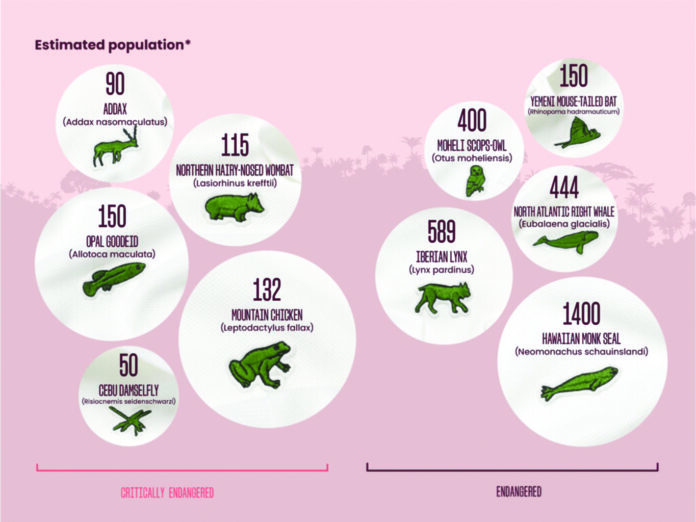Mother Nature and its species are disappearing at an alarming speed. Since the industrial revolution, our planet’s environment has been changing rapidly due to the excessive emission of greenhouse gases and chlorofluorocarbons, causing significant harm to both Mother Nature and its species. Fortunately, more people worldwide have become aware of the risks associated with these issues and have initiated individual and collective efforts to protect and preserve nature and its species.
Influential figures such as Sir David Attenborough and the late Australian conservationist Steve Irwin, who passed away over a decade and a half ago, have educated millions through their remarkable documentaries, inspiring global endeavours to safeguard our environment. However, despite these efforts, the challenges remain immense, and there is much more to be done to ensure the protection and preservation of our planet.
Globally around 50 percent of all species are at the risk of extinction according to estimations. According to the International Union for the Conservation of Nature, over 16,300 species are listed as endangered, with 42,100 species threatened with extinction worldwide. If the current disappearance rate continues, more than one million species could become extinct by 2050. Many of us mostly love animals like lions, cheetahs, elephants, zebras, tigers, rhinoceroses, and pandas. Unfortunately, many of these beloved wild animals could disappear by the end of this century. According to WWF, there are only about 23,000 to 39,000 lions left in the wild, and they could be extinct by 2050. The cheetah population is even more dire, with fewer than 7,000 individuals remaining. The global elephant population stands at 400,000, but tragically, over 100 African elephants are lost every day due to poaching and habitat destruction. The rhinoceros population totals 27,000, and there are fewer than 4,500 tigers left in the wild. All these species are disappearing, and our future generations may not have the chance to see them.
Pakistan is home to some of the world’s most unique and rare fauna and flora. This is due to Pakistan’s diverse landscape. From snow-covered high-altitude peaks in the north to the sandy beaches of the south, Pakistan’s landscape provides habitats including barren deserts, vast plains, lowland wetlands, alpine valleys, and lush green meadows. This wide range of habitat is home to unique and rare species such as the markhor, snow leopard, Indus river dolphin, musk deer, Indian pangolin, nilgai, bharal, goitered gazelle, Siberian ibex, Sindhi ibex, lynx, wild goat, leopard, urial, Marco Polo sheep, Himalayan brown bear, and blackbuck. Regrettably, a significant number of these species face imminent risks due to illegal poaching, hunting, deforestation, and habitat destruction.
Pakistan’s national animal, the markhor, is classified as Near Threatened by the IUCN. Creatures such as the Indus river dolphin, Indian pPangolin, and white-bellied musk deer are categorized as Endangered. Species including the Marco Polo sheep and Siberian ibex hover close to being classified as Near Threatened, while others such as the urial, goitered gazelle, Sindhi ibex, snow leopard, and Indian leopard fall into the Vulnerable category. Tragically, the Himalayan brown bear is listed as Critically Endangered.
Pakistan should consider safeguarding nature’s rights at the national level. This includes implementing a complete ban on animal hunting, halting deforestation, reducing carbon emissions, and promoting national awareness.
Globally, the causes of these crises include climate change, global warming, recently arrived global boiling, poaching, and illegal hunting, habitat destruction, rapid population growth, and various forms of pollution. Global warming could lead to the submergence of several international cities in the near future, including Venice, Jakarta, Mumbai, and, sadly, Pakistan’s economic hub, Karachi.
Climate change and global warming are jointly responsible for extreme and unpredictable weather patterns, floods, droughts, rising temperatures, health issues, and a rapid loss of biodiversity. Pakistan’s biodiversity faces threats such as deforestation, rapid population growth, habitat destruction, and, sadly, illegal hunting and poaching.
The alarming rate of disappearance is a pressing concern, but we can take control and address it. Time is running out, and more effective efforts are urgently needed. Across the globe, numerous communities and organizations are dedicated to combating these crises. People are becoming increasingly aware of these issues, and governments worldwide are taking steps to safeguard nature and its species.
In 2008, Ecuador became the first country to grant legal rights to Mother Nature in its constitution, marking a significant milestone in nature conservation. Following Ecuador’s example, several other countries, including the United States, Bolivia, India, New Zealand, Panama, Australia, Colombia, Bangladesh, and Canada, have also granted legal rights to nature.
Pakistan should consider safeguarding nature’s rights at the national level. This includes implementing a complete ban on animal hunting, halting deforestation, reducing carbon emissions, and promoting national awareness. Effective legislation would be a crucial step in preserving nature. Lastly, establishing more national parks, wildlife sanctuaries, and protected areas with improved management is of utmost importance.






















